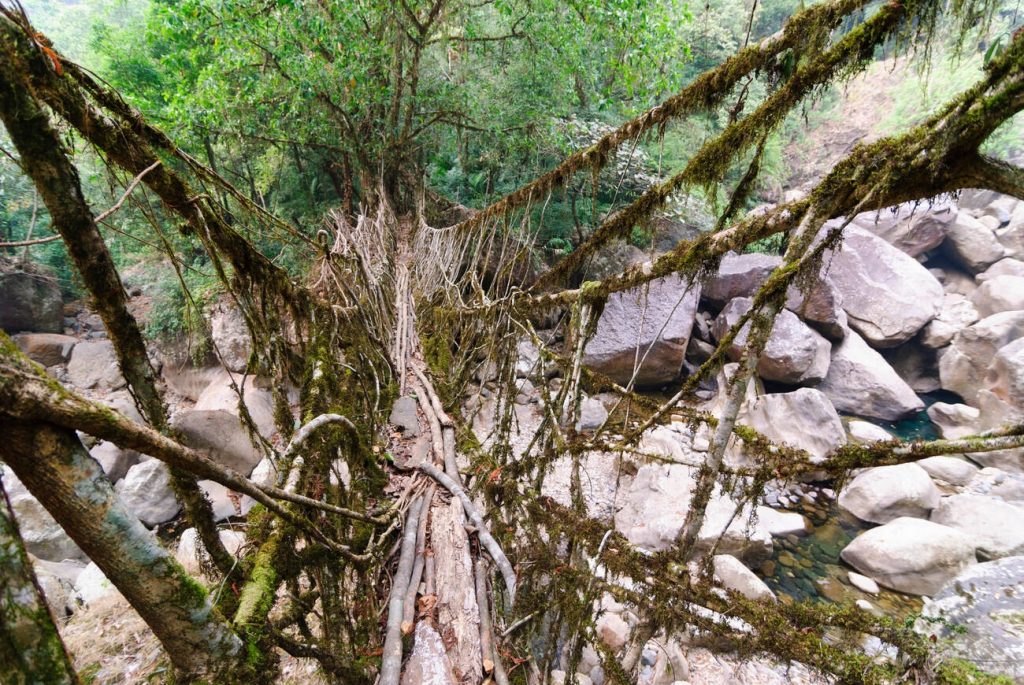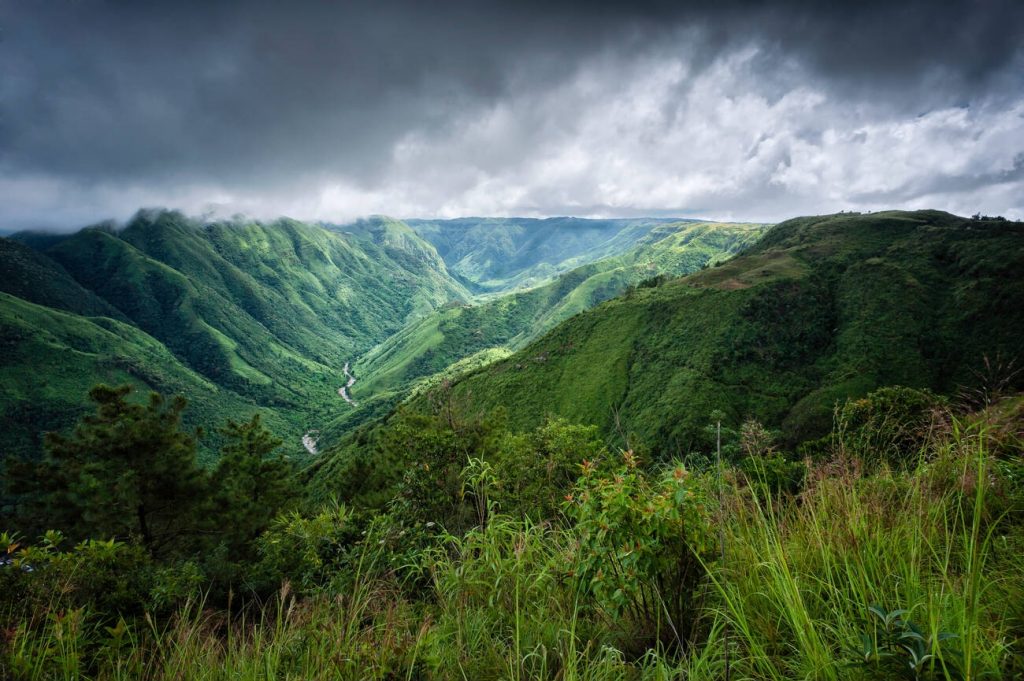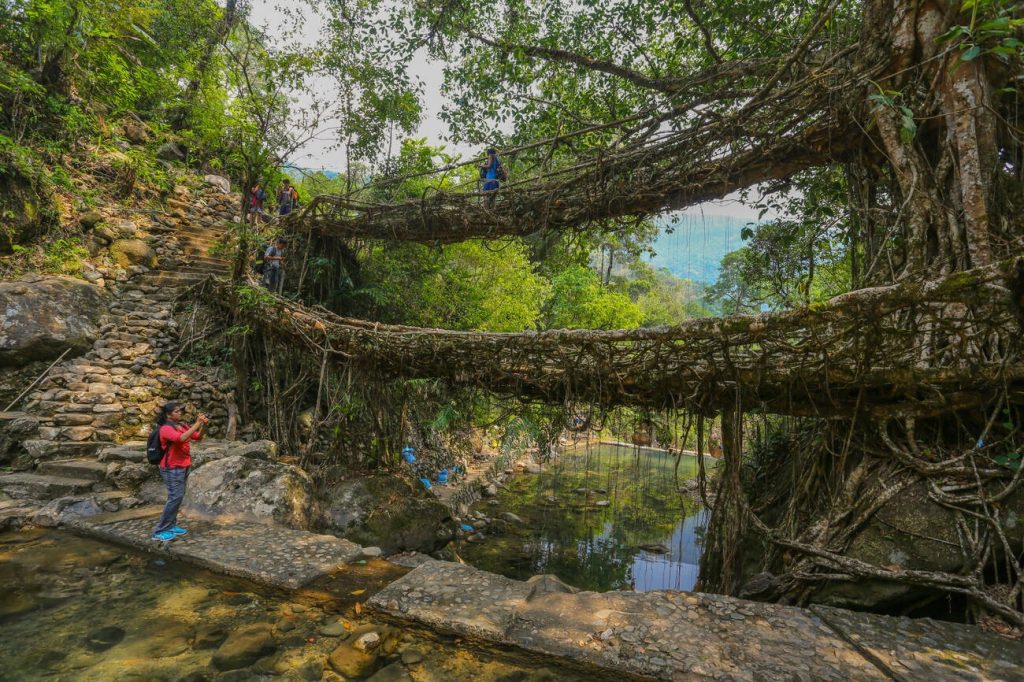The Living Root Bridge of Meghalaya is a one-of-a-kind attraction that is mostly connected with this Indian state. It will get you all hooked when you first hear about it. It is, of course, one of the top things to see and do in Meghalaya. The Meghalaya Living Root Bridge can be found throughout the state, and their lengths and structures vary. The Nongriat double-decker bridge in Cherrapunji is the one that will keep you very interested in seeing, and also; it involves a long hike.
The ever-changing Meghalaya bridges are formed of intertwined thick roots that give the structure formidability and accommodate 50 or more people at once. They are cultivated by skilled Khasi and Jaintia tribes who have perfected the art of creating root bridges across elevated banks of streams running through Meghalaya’s deep forests.
What is a living root bridges of meghalaya?
A living root bridge is a sort of basic suspension bridge made from the roots of live plants. They are common in the southern section of Meghalaya, a state in northeast India. The Khasi and Jaintia people of the mountainous terrain along the southern section of the Shillong Plateau make them from the aerial roots of rubber fig trees. Most bridges are found on steep subtropical moist broad leaf forest slopes between 50 and 1150 metres above sea level. The roots can naturally develop thick and strong as long as the tree from which they are generated is healthy. New roots might sprout during the tree’s life to strengthen the bridge and must be clipped or controlled.
Some bridges, if mature, may carry up to 50 or more people and have a lifespan of up to 150 years. Many bridges have deteriorated or become unusable due to a lack of active maintenance. In the Indian state of Nagaland, root bridges have also been discovered.
The Origins

Rivers in Meghalaya floods the state during India’s monsoon season, which runs from June to September, stranding local residents. The Khasi people used to travel by building bamboo bridges, but these man-made constructions could not survive harsh storms and quickly decayed.
As a result, the Khasi people turned to the Indian rubber plant, also known as the Indian rubber fig. Aerated roots of Ficus elastica, a fig species, can be knotted, twisted, and moulded into bridge-like constructions.
On the other hand, growing a living root bridge is neither quick nor easy. The tree’s roots take 10 to 30 years to resemble a bridge. However, once the bridge is built, it can last millennia and be strong enough to hold up to 35 people simultaneously. The Khasi people traditionally begin the procedure by planting a tree on each side of a riverbank. The tree’s roots are then threaded and twisted over a temporary wooden bridge, which helps guide the roots across the river. When the roots have grown long enough to reach the other side of the river, they begin to plant themselves into the ground. The roots develop and strengthen over time, strengthening the bridge. Although no one knows when the first live root bridge was built, recorded records of the structures date back more than a century.
Facts about the Living Root Bridges Of Meghalaya

Rubber tree roots, also known as Ficus elastica tree, are used to make the Living Root Bridge. Some of the root bridges are more than 100 feet long and take ten to fifteen years to perfect. These roots can live for up to 500 years once completely formed. While some of the roots decay as a result of their constant contact with water, others sprout to compensate for the ones that have decayed, ensuring the bridge’s durability. The double-decker root bridge in Cherrapunji and the single-decker root bridge in Shillong are the only two living root bridge in the world, and they are a major attraction in the Northeast.
Location of the living root bridges of Meghalaya
Living Root Bridge are among India’s most under-visited destinations in the West Jaintia Hills district, the East Khasi Hills district, and a few other parts of Meghalaya. The best root bridges, on the other hand, are centred near Cherrapunji and Shillong. Here’s how to get to these stunning locations. Both of these towns may be reached from Guwahati.
How to reach Shillong and Cherrapunji
Guwahati, a prominent city in Northeast India, serves as a hub for all visitors to the region. From Guwahati, there are numerous commute choices to all of the Northeast’s destinations.
By air: Guwahati airport, located 123 kilometres from Shillong, is well connected to major Indian airports. When arriving in Shillong from the airport, most people choose to take a reserved cab. Shillong to Cherrapunji is 54 kilometres long and takes 2 hours to go by local bus or taxi.
By train: The nearest rail station to Meghalaya is Guwahati Railway Station. It is well connected to other important railway stations across India, making travel to Shillong and other key Northeast Indian cities quite convenient. A taxi or a private/government bus can traverse the 148 km trip between Guwahati and Cherrapunji in 4 hours.

By road: Volvo and government buses run regularly from Guwahati to Shillong and Cherrapunji. The 99-kilometer journey from Guwahati to Shillong is filled with breathtaking scenery, making it a must-see for all travelers.
The best time to visit the Living Root Bridges
Throughout the year, Meghalaya has a pleasant climate. For most portion of the year, the weather is nice and misty. However, avoid driving during the monsoon season, which runs from June to August, because roads get slick. It gets tough to walk in the woods and descend steps.
Simply fill your backpack for the remainder of the year, and don’t forget to bring enough winter clothing
Double Decker Living Root Bridge In Cherrapunjee

The double-decker root bridge is the Mecca of all root bridges, requiring a two-hour trek and a steep descent of 2400 feet via a series of intricately built 3500 steps. The trek begins in Tyrna village and ends in Nongthymmai Village within 45 minutes. The path becomes less strenuous and more spectacular, involving crossing two narrow steel suspension bridges across fast-flowing rivers. The height of these bridges will enthral you, and it will be a hard challenge for those afraid of heights.
Then, appearing from the clouds, you’ll see a blackboard with the words ‘Nongriat Village’ scrawled on it hung on the bark of a tree. The Double-Decker root bridges can be found in Nongriat. Once you’ve arrived at the location, you’ll want to stay there indefinitely due to its rejuvenating influence on the fatigued body and soul. Because the lower arm of the Double-Decker root bridge had become impassable due to heavy rains, the higher arm was created. The residents are now building a third that will be solely for tourism. Being here is wonderful, but you’re quickly reminded of your lengthy journey back to Tyrna. A homestay and a local community guesthouse exist if you want to stay the night.
The Living Root Bridge of Mawlynnong
If you’re looking for an alternative to Cherrapunjee, this is a terrific place to go. The village has its own guest house, and the residents welcome visitors with open arms and bright grins. The hamlet refers to itself as a “garden village” because the grounds are immaculately maintained, with no waste paper or other litter evident. The Khasis are very protective of their natural environment, and even going outside to relieve yourself can result in a fine. These individuals are working together to establish Mawlynnong as a tourist destination using environmentally friendly methods.
This Living Root Bridge is a natural root bridge located at Riwai hamlet near Mawlynnong in Meghalaya, around 3 kilometres from Mawlynnong Bus Stop. It is one of Meghalaya’s natural wonders and one of the top locations to see in Mawlynnong. From the parking area, it is approximately 300 metres to the bridge. On the other hand, the aesthetic benefits will make visitors forget about their discomfort during the walk. The people of Riwai charge tourists a small fee to help them maintain the area.
Shillong to Mawlynnong is 78 kilometres away, which can be covered in 2.5 hours by cab. Take a shared Sumo or a vehicle to Police Bazaar from Sumo Stand in Bara Bazaar, which is a 15-minute walk away. Use the assistance of locals for correct directions. To go to the Living Root Bridge, go to Riwai village, which is a few kilometres before Mawlynnong. From there, it’s a 15-minute walk to the bridge.
Other Living Root Bridges
There are many living root bridge scattered around Meghalaya but only 11 of those are functional. Some other well known bridges are:
Ummunoi Root Bridge
Laitkynsew village is the starting point. Location: Ummunoi River, Nongkroh, via Sohsarat hamlet, near Siej village. One-way distance is two kilometres. Return time is three to four hours. 1,400 feet of descent This 17-meter-long (54-foot-long) root bridge is one of the region’s oldest and most popular tourist attractions, because to its combination of accessibility and majesty.
Umkar Root Bridge
Siej village is the starting point and site. One-way distance is half a kilometre. Return in 30 minutes. This root bridge, the ideal alternative for those lacking fitness or movement, was partially washed away by flash floods. The people are replanting it, which is fascinating to watch. During the monsoon season, a waterfall cascades alongside the bridge.
Ritymmen Root Bridge
This bridge can be visited on the way to the Double Decker root bridge) Tyrna village is the starting point. Nongthymmai village is the location. Return time: one and a half to two hours. This root bridge is the world’s longest live root bridge, measuring 30 metres (100 feet).
Mawsaw Root Bridge:
Continue walking for another 20-30 minutes past the Double Decker root bridge if you’re not too tired and have the time. Natural swimming pools along this root bridge are a highlight (albeit they’re dangerous during monsoon season).
Living Root Bridges and the Future
According to The Living Root Bridge Project, Meghalaya residents increasingly use contemporary technologies and materials to create bridges. Using metals and wires to build bridges has become a more convenient and faster alternative to using the roots of the Indian rubber fig to create structures.
Others, on the other hand, are working hard to keep the tradition alive. A third root bridge is being grown at the Double-Decker root bridge, which will sit above the second bridge and be completed within a decade. Since the Double-Decker bridge is already a popular tourist destination in Meghalaya, the purpose of creating a third bridge is to bring even more visitors to the hamlet, raising awareness of the Khasi people’s imaginative traditions and ensuring that the bridges are preserved for millennia.
FAQ
-
How many living root bridges are there in the world?
There are roughly 100 known live root bridges in Meghalaya. The first documented account of the Sohra (Cherrapunji) bridge can be found in the Asiatic Society of Bengal Journal from 1844. Nongriat’s double-decker living root bridge, around 65 kilometres from Shillong, is also well-known.
-
How is living root bridge formed?
A living root bridge is made by guiding the pliable roots of the Ficus elastica tree across a stream or river, then allowing the roots to grow and strengthen over time until they can support a person’s weight.
-
How long does a root bridge take to become strong enough to bear the weight of people?
A new root bridge takes around 15 years to develop strong enough to support the weight of individuals passing it. It will, however, continue to grow and strengthen over time. Although no one knows for sure, several of the bridges are said to be hundreds of years old.
-
How old is the living root bridge?
Meghalaya’s living root bridges, a few of which are estimated to be over 500 years old, attract tourists from all over the world



